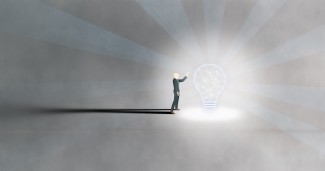Does humor appreciation have a brain signature? In a new study published in Neuropsychologia, Vadim Axelrod at Bar-Ilan University in Tel Aviv, in collaboration with Lionel Naccache (Sorbonne University, AP-HP) at Paris Brain Institute, decrypts the cerebral underpinnings of the emotions we experience in a movie theater. Taking advantage of the emotional synchronization that unites viewers of the same film, the researchers discovered that the funniest sequences in a Charlie Chaplin movie were associated with a specific cerebral electrical orchestration. This promising first step will have to be followed by studies aimed at reproducing this discovery.
Humor is essential for easing interpersonal tensions, reducing stress, relieving physical and moral suffering, and even improving the body's immune response. Given this central role in our lives, it is desirable to understand the cognitive and neuronal mechanisms on which it is based. At the same time, what makes us laugh appears to be highly dependent on a given culture, era, or context. It is quite improbable to chuckle at the facetious graffiti of ancient Rome or the comic dialogues of Noh theatre... In that case, how can we generalize how humor works?
A large part of humanity certainly shares some aspects of humor. Humans are particularly susceptible to the comedic powers of non-verbal humor – such as gesticulations, falls, unwarranted blows, or imitations. Physical comedy is the basis of slapstick, burlesque, clowning, and mime. It notably permeates the silent films of Charlie Chaplin, known for generating hilarity across cultures.
Researchers at Paris Brain Institute and Bar-Ilan University in Tel Aviv wanted to take advantage of the astonishing power of Chaplin's antics to study the neural substrate of humor... using a new tool. Until now, fMRI has been the preferred technique for this type of research, and several studies have shown the involvement of the temporal lobe in the processing of droll stimuli. However, the signal obtained via fMRI does not allow the detection of the entire spectrum of electromagnetic waves generated by the brain: part of the information is lost.
In-depth comedy
To fill this gap in understanding, the researchers analyzed intracerebral electrophysiological recordings, which make it possible to look at neuronal activity directly with a high spatial and temporal precision (at the millisecond scale) in several cortical areas. Using Paris Brain Institute's CENIR neuroimaging platform, they studied thirteen epileptic patients who had been implanted with deep brain electrodes as part of a pre-surgical assessment of refractory epilepsy.
The researchers asked the patients to watch a three-minute excerpt from Charlie Chaplin's Circus (1928) while their brain activity was measured live. Beforehand, the amusing nature (or not) of each sequence had been evaluated, frame by frame, by a group of healthy volunteers.
The team then compared the patients' neural activity recorded during the funniest scenes in the film with that recorded during the least funny scenes.
We observed that the funniest sequences were associated with an increase in high-frequency gamma waves and a decrease in low-frequency waves. For the least amusing scenes, it was the other way around. These results indicate that high-frequency neural activity, which is seen in tasks that require a lot of cognitive engagement, such as work, is also a mark of humor appreciation. Conversely, scenes that are not funny – such as transition sequences where the character moves from one place to another without doing anything – promote inattention and introspection... and a preponderance of low frequencies.
More importantly, this inverse relationship between high and low frequencies was observed in temporal lobe regions but not in others. It seems that humorous content is not processed in the same way throughout the cortex and depends on brain areas and functions.
Incongruity detection machines
According to a dominant theory, the treatment of humor is based on two complementary mechanisms. First, the detection of an incongruous element of reality (for example, in Charlie Chaplin's The Gold Rush (1925), the hero eats shoelaces like spaghetti). Then, the emergence of a positive emotion related to this incongruity. What is funny would therefore be both unexpected and pleasant and involve two neural circuits: cognitive and emotional.
Our results support this theory, as we confirm the prominent role of the temporal lobe in the appreciation of humor. As the anterior parts of this area are involved in semantic memory, we can imagine that their activity is linked to the analysis of the scene and the detection of its incongruous content. Conversely, the activation of its posterior parts could correspond to understanding the unusual – and therefore amusing – aspect of certain social interactions.
Future studies will have to show the simultaneous activation of cognitive and emotional neural circuits to formally validate the theory of incongruity. Researchers will also need to look at other areas involved in cognition (such as the inferior frontal gyrus and anterior cingulate cortex) and emotions.
Finally, there can only be a generalization about the mechanisms of humor by studying other forms of it.
Here, we only looked at reactions to the slapstick genre. Using longer videos, with more complex social interactions where jokes, irony, sarcasm, or references jokes are present, we can expand our understanding of this magnificent, uniquely human phenomen
Funding
This study was funded by the Alon Fellowship of the Israeli Council for Higher Education, the "Investissements d'avenir" program, and the OCIRP Foundation.
Sources
Axelrod, v. et al. Intracranial study in humans: Neural spectral changes during watching comedy movie of Charlie Chaplin. Neuropsychologia(2023). 10.1016/j.neuropsychologia.2023.108558







